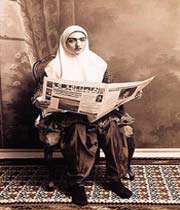 In recent years the parameters of Islamic art (particularly as defined by museums, commercial art galleries, and private collections) have expanded to include contemporary works by artists from the Middle East. These artists draw inspiration from their own cultural traditions, using techniques and incorporating imagery and ideas from earlier periods. They are not so much reinventing Islamic art as they are repurposing it so that it becomes more clearly a vehicle for personal expression, freed from the constraints of patronage and functionality.
In recent years the parameters of Islamic art (particularly as defined by museums, commercial art galleries, and private collections) have expanded to include contemporary works by artists from the Middle East. These artists draw inspiration from their own cultural traditions, using techniques and incorporating imagery and ideas from earlier periods. They are not so much reinventing Islamic art as they are repurposing it so that it becomes more clearly a vehicle for personal expression, freed from the constraints of patronage and functionality.
Writing in Arabic is a consistent and powerful theme in classical Islamic art, as can be seen throughout these Web pages, but it also resonates with many artists today as both an art form and a means of addressing their religious or cultural identity. One such artist is Ali Omar Ermes (Libya, active England, b. 1945), whose calligraphic work, fluidly rendered with a brush rather than the traditional reed pen, often focuses on a single letter. In his version of the letter kaf (K), the bold, black mark, dramatically offset against the light paper, recalls the black inscriptions on a white ground that characterize tenth-century ceramic wares from the eastern Iranian world. Although these works of art are widely separated by time and purpose, they share a common artistic vocabulary based in the Arabic alphabet. Situated among examples of classical Islamic art, the contemporary calligraphy is imbued with a sense of timelessness while it in turn pulls the historical objects into the present day, giving them a new relevance.
Shadi Ghadirian (Iran, b. 1974), who works in the medium of photography, uses her art to express herself as an Iranian and as a woman. Ghadirian’s best-known body of work, the Qajar Series, was inspired by nineteenth-century studio portraits of women depicted in the fashion of the day: thick, black eyebrows; headscarves; and short skirts worn over baggy trousers. In order to re-create the earlier photographic settings, Ghadirian employed painted backdrops and dressed her models in vintage clothing from the late 1800s. She added modern objects to these traditional scenes, such as a Pepsican, a boom box, or, a bicycle and an avant-garde Tehran newspaper. She has said of her work, “My pictures became a mirror reflecting how I felt: we are stuck between tradition and modernity.”
LACMA has only just begun to acquire contemporary art of the Middle East within the context of our Islamic collection. We do so in the belief that the function, strength, and ultimate success and relevance of the collection should not be based solely on exploring this art as a means to better understand the past. The collection can also be seen as a way to build creative links between the past, the present, and the future. We hope to expand this section of our Islamic web pages as the collection grows.
َ
Also it is recommended to see:

No comments:
Post a Comment